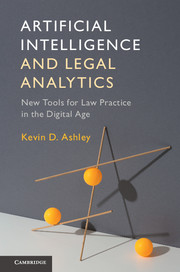Book contents
- Frontmatter
- Dedication
- Contents
- List of illustrations
- List of tables
- Acknowledgments
- PART I COMPUTATIONAL MODELS OF LEGAL REASONING
- 1 Introducing AI & Law and Its Role in Future Legal Practice
- 2 Modeling Statutory Reasoning
- 3 Modeling Case-based Legal Reasoning
- 4 Models for Predicting Legal Outcomes
- 5 Computational Models of Legal Argument
- PART II LEGAL TEXT ANALYTICS
- PART III CONNECTING COMPUTATIONAL REASONING MODELS AND LEGAL TEXTS
- Glossary
- Bibliography
- Index
3 - Modeling Case-based Legal Reasoning
from PART I - COMPUTATIONAL MODELS OF LEGAL REASONING
Published online by Cambridge University Press: 13 July 2017
- Frontmatter
- Dedication
- Contents
- List of illustrations
- List of tables
- Acknowledgments
- PART I COMPUTATIONAL MODELS OF LEGAL REASONING
- 1 Introducing AI & Law and Its Role in Future Legal Practice
- 2 Modeling Statutory Reasoning
- 3 Modeling Case-based Legal Reasoning
- 4 Models for Predicting Legal Outcomes
- 5 Computational Models of Legal Argument
- PART II LEGAL TEXT ANALYTICS
- PART III CONNECTING COMPUTATIONAL REASONING MODELS AND LEGAL TEXTS
- Glossary
- Bibliography
- Index
Summary
INTRODUCTION
Since legal rules employ terms and concepts that can be vague and open-textured, a computational model of reasoning with cases would help. Courts often interpret the meaning of legal terms and concepts by drawing analogies across cases illustrating how a term or concept has been applied in the past.
This chapter presents computational models of analogical reasoning with legal cases. The models are based on three basic approaches. The first, prototypes and deformations, focuses on how to decide a case by constructing a theory based on past cases. The second, dimensions and legal factors, employs stereotypical patterns of fact that strengthen or weaken a side's argument concerning a legal claim or concept. The third, exemplar-based explanations (EBEs), represents legal concepts in terms of prior courts’ explanations of why a concept did or did not apply.
The models illustrate how to represent legal cases so that a computer program can reason about whether they are analogous to a case to be decided. In particular, they illustrate ways in which a program can compare a problem and cases, select the most relevant cases, and generate legal arguments by analogy for and against a conclusion in a new case.
Legal rules and concepts are promulgated for normative purposes. Teleological arguments (i.e., arguments from the purposes or values served by a rule) play an important role in drawing legal analogies. Computational models that integrate legal rules, intermediate legal concepts (ILCs) from those rules, and cases applying the rules need to take underlying values into account. This chapter introduces techniques for computationally modeling teleological reasoning by integrating values into the measures of case relevance and models of legal analogy.
None of these systems deals directly with legal texts. Instead, they work on the basis of formal representations of case facts and legal concepts that have been manually constructed. The assumption, however, has been that one day, these case representations will be extracted automatically from natural language texts of case opinions or fact summaries. With text analytics, that day is fast approaching. The chapter contrasts how amenable the different case representations are to text analytic approaches and their implications for cognitive computing.
- Type
- Chapter
- Information
- Artificial Intelligence and Legal AnalyticsNew Tools for Law Practice in the Digital Age, pp. 73 - 106Publisher: Cambridge University PressPrint publication year: 2017



